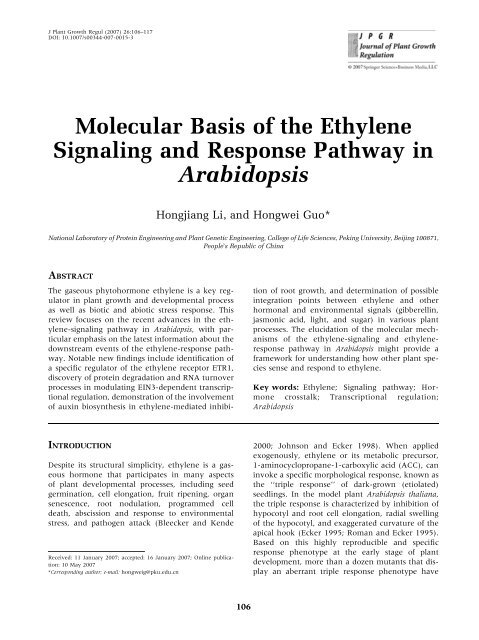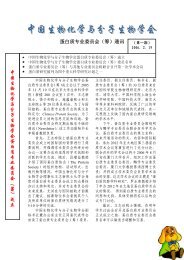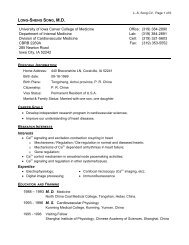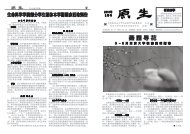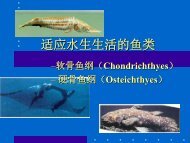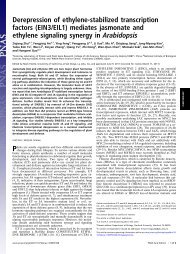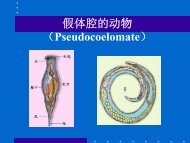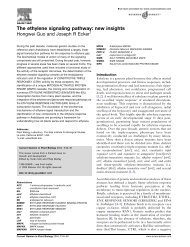Molecular Basis of the Ethylene Signaling and Response Pathway ...
Molecular Basis of the Ethylene Signaling and Response Pathway ...
Molecular Basis of the Ethylene Signaling and Response Pathway ...
You also want an ePaper? Increase the reach of your titles
YUMPU automatically turns print PDFs into web optimized ePapers that Google loves.
J Plant Growth Regul (2007) 26:106–117<br />
DOI: 10.1007/s00344-007-0015-3<br />
<strong>Molecular</strong> <strong>Basis</strong> <strong>of</strong> <strong>the</strong> <strong>Ethylene</strong><br />
<strong>Signaling</strong> <strong>and</strong> <strong>Response</strong> <strong>Pathway</strong> in<br />
Arabidopsis<br />
Hongjiang Li, <strong>and</strong> Hongwei Guo*<br />
National Laboratory <strong>of</strong> Protein Engineering <strong>and</strong> Plant Genetic Engineering, College <strong>of</strong> Life Sciences, Peking University, Beijing 100871,<br />
PeopleÕs Republic <strong>of</strong> China<br />
ABSTRACT<br />
The gaseous phytohormone ethylene is a key regulator<br />
in plant growth <strong>and</strong> developmental process<br />
as well as biotic <strong>and</strong> abiotic stress response. This<br />
review focuses on <strong>the</strong> recent advances in <strong>the</strong> ethylene-signaling<br />
pathway in Arabidopsis, with particular<br />
emphasis on <strong>the</strong> latest information about <strong>the</strong><br />
downstream events <strong>of</strong> <strong>the</strong> ethylene-response pathway.<br />
Notable new findings include identification <strong>of</strong><br />
a specific regulator <strong>of</strong> <strong>the</strong> ethylene receptor ETR1,<br />
discovery <strong>of</strong> protein degradation <strong>and</strong> RNA turnover<br />
processes in modulating EIN3-dependent transcriptional<br />
regulation, demonstration <strong>of</strong> <strong>the</strong> involvement<br />
<strong>of</strong> auxin biosyn<strong>the</strong>sis in ethylene-mediated inhibition<br />
<strong>of</strong> root growth, <strong>and</strong> determination <strong>of</strong> possible<br />
integration points between ethylene <strong>and</strong> o<strong>the</strong>r<br />
hormonal <strong>and</strong> environmental signals (gibberellin,<br />
jasmonic acid, light, <strong>and</strong> sugar) in various plant<br />
processes. The elucidation <strong>of</strong> <strong>the</strong> molecular mechanisms<br />
<strong>of</strong> <strong>the</strong> ethylene-signaling <strong>and</strong> ethyleneresponse<br />
pathway in Arabidopsis might provide a<br />
framework for underst<strong>and</strong>ing how o<strong>the</strong>r plant species<br />
sense <strong>and</strong> respond to ethylene.<br />
Key words: <strong>Ethylene</strong>; <strong>Signaling</strong> pathway; Hormone<br />
crosstalk; Transcriptional regulation;<br />
Arabidopsis<br />
INTRODUCTION<br />
Despite its structural simplicity, ethylene is a gaseous<br />
hormone that participates in many aspects<br />
<strong>of</strong> plant developmental processes, including seed<br />
germination, cell elongation, fruit ripening, organ<br />
senescence, root nodulation, programmed cell<br />
death, abscission <strong>and</strong> response to environmental<br />
stress, <strong>and</strong> pathogen attack (Bleecker <strong>and</strong> Kende<br />
Received: 11 January 2007; accepted: 16 January 2007; Online publication:<br />
10 May 2007<br />
*Corresponding author; e-mail: hongweig@pku.edu.cn<br />
2000; Johnson <strong>and</strong> Ecker 1998). When applied<br />
exogenously, ethylene or its metabolic precursor,<br />
1-aminocyclopropane-1-carboxylic acid (ACC), can<br />
invoke a specific morphological response, known as<br />
<strong>the</strong> ‘‘triple response’’ <strong>of</strong> dark-grown (etiolated)<br />
seedlings. In <strong>the</strong> model plant Arabidopsis thaliana,<br />
<strong>the</strong> triple response is characterized by inhibition <strong>of</strong><br />
hypocotyl <strong>and</strong> root cell elongation, radial swelling<br />
<strong>of</strong> <strong>the</strong> hypocotyl, <strong>and</strong> exaggerated curvature <strong>of</strong> <strong>the</strong><br />
apical hook (Ecker 1995; Roman <strong>and</strong> Ecker 1995).<br />
Based on this highly reproducible <strong>and</strong> specific<br />
response phenotype at <strong>the</strong> early stage <strong>of</strong> plant<br />
development, more than a dozen mutants that display<br />
an aberrant triple response phenotype have<br />
106
<strong>Signaling</strong> Components <strong>of</strong> <strong>the</strong> <strong>Ethylene</strong> <strong>Response</strong> <strong>Pathway</strong> 107<br />
been identified in Arabidopsis over <strong>the</strong> past decades.<br />
These mutants can be classified into five distinct<br />
categories: (1) ethylene overproduced mutants,<br />
such as eto1 (ethylene overproduction1), eto2, eto3<br />
(Kieber <strong>and</strong> o<strong>the</strong>rs 1993); (2) constitutive ethylenesignaling<br />
mutants, including ctr1 (constitutive triple<br />
response1) <strong>and</strong> ran1 (responsive to antagonist1)/ctr2<br />
(Kieber <strong>and</strong> o<strong>the</strong>rs 1993; Hirayama <strong>and</strong> o<strong>the</strong>rs<br />
1999); (3) ethylene-insensitive or ethylene-resistant<br />
mutants that show a partial or complete defect in all<br />
aspects <strong>of</strong> <strong>the</strong> triple response phenotype, for<br />
example, etr1 (ethylene receptor1/ethylene resistant1),<br />
etr2, ein2 (ethylene insensitive2), ein3, ein4, ein5, ein6,<br />
eil1 (Roman <strong>and</strong> o<strong>the</strong>rs 1995; also see review by<br />
Guo <strong>and</strong> Ecker 2004); (4) mutants that display tissue-specific<br />
ethylene insensitivity, including hls1<br />
(hookless1), eir1 (ethylene insensitive root1), <strong>and</strong> several<br />
auxin-resistant mutants (Lehman <strong>and</strong> o<strong>the</strong>rs 1996;<br />
see review by Stepanova <strong>and</strong> Alonso 2005); (5)<br />
mutants hypersensitive to exogenous ethylene or<br />
ACC, like ebf1 (ein3-binding F-box protein1), ebf2 (Guo<br />
<strong>and</strong> Ecker 2003; Potuschak <strong>and</strong> o<strong>the</strong>rs 2003; Gagne<br />
<strong>and</strong> o<strong>the</strong>rs 2004), eer1 (enhanced ethylene response1)<br />
(Larsen <strong>and</strong> Chang 2001), <strong>and</strong> rte1 (reversion to ethylene<br />
sensitivity1) (Resnick <strong>and</strong> o<strong>the</strong>rs 2006).<br />
A largely linear ethylene signal transduction<br />
pathway from hormone perception at <strong>the</strong> endoplasmic<br />
reticulum (ER) to transcriptional regulation in<br />
<strong>the</strong> nucleus has been defined through <strong>the</strong> combination<br />
<strong>of</strong> genetic <strong>and</strong> molecular analysis <strong>of</strong> those mutants<br />
(see reviews by Nehring <strong>and</strong> Ecker 2004; Chen<br />
<strong>and</strong> o<strong>the</strong>rs 2005). In Arabidopsis, ethylene is perceived<br />
by a family <strong>of</strong> five membrane-associated<br />
receptors (ETR1, ETR2, ERS1, ERS2, <strong>and</strong> EIN4) that<br />
possess sequence similarity with bacterial two-component<br />
His kinases (Bleecker 1999; Schaller <strong>and</strong><br />
Kieber 2002). <strong>Ethylene</strong> binds to <strong>the</strong> receptors via a<br />
copper co-factor, <strong>and</strong> a copper transporter RAN1 (a<br />
homolog <strong>of</strong> <strong>the</strong> human Menkes Wilson P-type<br />
ATPase) is likely involved in copper delivery to <strong>the</strong><br />
receptors (Hirayama <strong>and</strong> o<strong>the</strong>rs 1999; Woeste <strong>and</strong><br />
Kieber 2000). Two recent studies reported that RTE1,<br />
as well as <strong>the</strong> tomato homolog Gr, is a negative regulator<br />
<strong>of</strong> ethylene responses, <strong>and</strong> it was shown that<br />
RTE1 is an important regulator <strong>of</strong> ETR1 function<br />
(Resnick <strong>and</strong> o<strong>the</strong>rs 2006; Barry <strong>and</strong> Giovannoni<br />
2006). Genetic studies predict that <strong>the</strong> receptors<br />
remain active in <strong>the</strong> absence <strong>of</strong> ethylene gas, <strong>and</strong><br />
ethylene binding leads to functional inactivation <strong>of</strong><br />
<strong>the</strong> receptors. The ethylene-free receptors can<br />
somehow activate CTR1, a Raf-like Ser/Thr kinase,<br />
which is also a negative regulator <strong>of</strong> <strong>the</strong> pathway<br />
(Kieber <strong>and</strong> o<strong>the</strong>rs 1993). In <strong>the</strong> presence <strong>of</strong> ethylene,<br />
CTR1 loses its ability to repress a positive<br />
component <strong>of</strong> <strong>the</strong> pathway, <strong>the</strong> membrane protein<br />
ETHYLENE INSENSITIVE2 (EIN2). EIN2 is a crucial<br />
molecule in transmitting <strong>the</strong> ethylene signal, because<br />
ein2 loss-<strong>of</strong>-function mutations result in complete<br />
ethylene insensitivity in most if not all ethylene-related<br />
responses (Alonso <strong>and</strong> o<strong>the</strong>rs 1999).<br />
Despite its extreme importance in ethylene signal<br />
transduction, <strong>the</strong> subcellular localization <strong>and</strong> biochemical<br />
function <strong>of</strong> EIN2 remain a mystery (Alonso<br />
<strong>and</strong> o<strong>the</strong>rs 1999). EIN3, EIL1 (EIN3-Like1), EIN5,<br />
<strong>and</strong> EIN6 are also positive regulators that act fur<strong>the</strong>r<br />
downstream in <strong>the</strong> signaling pathway. EIN3 <strong>and</strong> EIL1<br />
are plant specific-transcription factors (Chao <strong>and</strong><br />
o<strong>the</strong>rs 1997), <strong>and</strong> <strong>the</strong> protein level <strong>of</strong> EIN3 is downregulated<br />
by <strong>the</strong> ubiquitin/proteasome pathway<br />
specifically mediated by SCF complexes containing F-<br />
box proteins EBF1/2 (EIN3 binding F-box protein1/<br />
2) (Guo <strong>and</strong> Ecker 2003; Potuschak <strong>and</strong> o<strong>the</strong>rs 2003;<br />
Gagne <strong>and</strong> o<strong>the</strong>rs 2004). Both EIN3 <strong>and</strong> EIL1 are<br />
found to induce <strong>the</strong> expression <strong>of</strong> o<strong>the</strong>r transcription<br />
factors such as ERFs (ethylene-response factors) <strong>and</strong><br />
EDFs (ethylene-responsive DNA-binding factors)<br />
(Solano <strong>and</strong> o<strong>the</strong>rs 1998; Alonso <strong>and</strong> o<strong>the</strong>rs 2003a),<br />
which represents a transcriptional cascade in <strong>the</strong><br />
ethylene-response pathway. EIN5, a 5¢ fi 3¢ exoribonuclease,<br />
has been recently shown to decrease <strong>the</strong><br />
level <strong>of</strong> EBF1 <strong>and</strong> EBF2 mRNAs through a yet unknown<br />
mechanism, <strong>and</strong> consequently stabilize EIN3<br />
protein (Guo <strong>and</strong> Ecker 2003; Olmedo <strong>and</strong> o<strong>the</strong>rs<br />
2006; Potuschak <strong>and</strong> o<strong>the</strong>rs 2006). Although EIN6 is<br />
also shown to act as a positive regulator <strong>of</strong> EIN3<br />
protein stability (Guo <strong>and</strong> Ecker 2003), it has not yet<br />
been characterized at <strong>the</strong> molecular level.<br />
In this review, we provide an update on <strong>the</strong><br />
molecular basis <strong>of</strong> <strong>the</strong> ethylene-signaling pathway in<br />
Arabidopsis (Figure 1), with particular focus on <strong>the</strong><br />
new findings <strong>of</strong> <strong>the</strong> downstream response pathway<br />
achieved in <strong>the</strong> past few years. These findings include<br />
identification <strong>of</strong> a novel regulator RTE1 in modulating<br />
<strong>the</strong> function <strong>of</strong> <strong>the</strong> ethylene receptor ETR1; discovery<br />
<strong>of</strong> protein degradation <strong>and</strong> mRNA turnover<br />
pathways in regulating EIN3; characterization <strong>of</strong> two<br />
auxin biosyn<strong>the</strong>tic enzymes WEI2/WEI7 that are<br />
responsible for ethylene-induced root cell inhibition,<br />
<strong>and</strong> determination <strong>of</strong> <strong>the</strong> underlying molecular<br />
mechanisms <strong>of</strong> cross-talks between ethylene <strong>and</strong><br />
o<strong>the</strong>r signals (such as GA, JA, light, <strong>and</strong> sugar) in<br />
plant growth <strong>and</strong> defense response (Figure 2).<br />
EARLY EVENTS OF ETHYLENE PERCEPTION<br />
AND SIGNALING<br />
The <strong>Ethylene</strong> Receptors<br />
<strong>Ethylene</strong> is perceived by a family <strong>of</strong> five membranebound<br />
proteins (ETR1, ETR2, ERS1, ERS2, <strong>and</strong>
108 H. Li <strong>and</strong> H. Guo<br />
b<br />
Figure 1. A model <strong>of</strong> <strong>the</strong> ethylene signal transduction<br />
pathway in Arabidopsis. <strong>Ethylene</strong> binding leads to <strong>the</strong><br />
inactivation <strong>of</strong> ER-localized receptors by an unknown<br />
mechanism. A novel membrane protein, RTE1, might<br />
specifically enhance <strong>the</strong> function <strong>of</strong> <strong>the</strong> ETR1 receptor. An<br />
inactive receptor is incapable <strong>of</strong> recruiting <strong>the</strong> negative<br />
regulator CTR1 to <strong>the</strong> ER membrane, which in turn shuts<br />
<strong>of</strong>f its activity. EIN2 is <strong>the</strong>n free from inhibition by CTR1<br />
<strong>and</strong> increases <strong>the</strong> nuclear accumulation <strong>of</strong> EIN3 protein by<br />
repressing its turnover, which is mediated by SCF complexes<br />
containing <strong>the</strong> F-box proteins EBF1/2. There are two<br />
possibilities for how EIN2 stabilizes EIN3: EIN2-derived<br />
signal modulates EIN3 directly or inhibits <strong>the</strong> SCF EBF<br />
complex. One <strong>of</strong> <strong>the</strong> EBF genes, EBF2, is induced by ethylene<br />
in an EIN3-dependent manner. Thus, a negative<br />
feedback loop is formed between EIN3 <strong>and</strong> EBF. EIN5, an<br />
exoribonuclease, seems to downregulate <strong>the</strong> level <strong>of</strong> EBF1<br />
<strong>and</strong> EBF2 mRNAs without affecting <strong>the</strong>ir half-life. The<br />
nuclear accumulation <strong>of</strong> EIN3 induces a large amount <strong>of</strong><br />
gene expression, <strong>and</strong> ultimately triggers various ethylene<br />
responses. Arrows <strong>and</strong> t-bars represent positive <strong>and</strong> negative<br />
regulations, respectively. Solid arrows <strong>and</strong> t-bars correspond<br />
to direct interactions <strong>and</strong> dotted lines indicate<br />
<strong>the</strong> likely existence <strong>of</strong> unidentified elements between<br />
upstream <strong>and</strong> downstream components.<br />
EIN4) in Arabidopsis (see reviews by Chang <strong>and</strong><br />
Stadler 2001; Chang <strong>and</strong> Bleecker 2004; Hall <strong>and</strong><br />
o<strong>the</strong>rs, in this issue). ETR1 has been localized to <strong>the</strong><br />
endoplasmic reticulum (ER), <strong>and</strong> <strong>the</strong> o<strong>the</strong>r four<br />
receptors possibly reside at <strong>the</strong> ER as well. On <strong>the</strong><br />
basis <strong>of</strong> structural similarities, <strong>the</strong> receptor family<br />
can be divided into two types: type-I receptors<br />
(ETR1 <strong>and</strong> ERS1) contain three transmembrane<br />
segments in <strong>the</strong> amino terminus <strong>and</strong> a carboxylterminal<br />
conserved histidine kinase domain; type-II<br />
receptors (ETR2, ERS2, <strong>and</strong> EIN4) contain four<br />
hydrophobic extensions at <strong>the</strong> amino terminus <strong>and</strong><br />
a degenerate histidine kinase domain that is presumed<br />
to lack catalytic activity in <strong>the</strong> carboxyl terminus.<br />
In addition to <strong>the</strong> transmembrane domain<br />
<strong>and</strong> His kinase domain, ETR1, ETR2, <strong>and</strong> EIN4<br />
also contain a receiver domain at <strong>the</strong>ir carboxyl<br />
end. The amino-terminal transmembrane domains<br />
are responsible for formation <strong>of</strong> disulfide-linked<br />
dimerization as well as ethylene binding, <strong>and</strong> thus<br />
<strong>the</strong>y function as <strong>the</strong> sensor domains <strong>of</strong> all five<br />
receptor proteins (Schaller <strong>and</strong> Bleecker 1995;<br />
OÕMalley <strong>and</strong> o<strong>the</strong>rs 2005). In addition, <strong>the</strong> sensor<br />
domain contains a copper co-factor that is required<br />
for high-affinity ethylene binding (Schaller <strong>and</strong><br />
Bleecker 1995; Rodriguez <strong>and</strong> o<strong>the</strong>rs 1999). Copper<br />
ions are delivered to <strong>the</strong> receptors by RAN1<br />
(Responsive to Antagonist1), a putative coppertransporting<br />
P-type ATPase homologous to <strong>the</strong> yeast<br />
Ccc2p <strong>and</strong> human Menkes Wilson disease proteins<br />
(Hirayama <strong>and</strong> o<strong>the</strong>rs 1999). In contrast to <strong>the</strong><br />
amino-terminal transmembrane domains, <strong>the</strong> biochemical<br />
functions <strong>of</strong> <strong>the</strong> carboxyl-terminal His<br />
kinase domains <strong>and</strong> receiver domains in <strong>the</strong> ethylene<br />
sensing <strong>and</strong> signaling are poorly understood.<br />
However, many recent studies on <strong>the</strong> functional<br />
analysis <strong>of</strong> ETR1 <strong>and</strong> its derivative forms have<br />
begun to unravel <strong>the</strong> detailed roles <strong>of</strong> <strong>the</strong>se domains<br />
in ethylene perception <strong>and</strong> signaling, although<br />
more conclusive data are still to be obtained to<br />
clarify <strong>the</strong> exact functions <strong>of</strong> <strong>the</strong>se domains (Wang<br />
<strong>and</strong> o<strong>the</strong>rs 2003; also see reviews by Chen <strong>and</strong><br />
o<strong>the</strong>rs 2005, <strong>and</strong> Hall <strong>and</strong> o<strong>the</strong>rs, 2007, in this issue).<br />
RTE1/GR, a Novel Regulator <strong>of</strong> <strong>the</strong> ETR1<br />
Receptor<br />
Genetic studies indicate that <strong>the</strong> ethylene receptors<br />
serve as negative regulators <strong>of</strong> <strong>the</strong> ethylene-signaling<br />
pathway (Hua <strong>and</strong> Meyerowitz 1998). However,
<strong>Signaling</strong> Components <strong>of</strong> <strong>the</strong> <strong>Ethylene</strong> <strong>Response</strong> <strong>Pathway</strong> 109<br />
genes, implying that RTE1 is required specifically for<br />
<strong>the</strong> etr1-2 mutant receptor to repress <strong>the</strong> downstream<br />
ethylene pathway. No biochemical function<br />
has been assigned to this interesting protein yet,<br />
except that RTE1 appears to be a membrane protein<br />
based on sequence prediction (Resnick <strong>and</strong> o<strong>the</strong>rs<br />
2006). In a separate study, a dominant Green-ripe<br />
(Gr) mutant <strong>of</strong> tomato was recently characterized at<br />
<strong>the</strong> molecular level, <strong>and</strong> its corresponding gene<br />
encodes a homolog <strong>of</strong> RTE1 (Barry <strong>and</strong> Giovannoni<br />
2006). Ectopic expression <strong>of</strong> Gr, ei<strong>the</strong>r by a gain<strong>of</strong>-function<br />
mutation or by a transgenic overexpression<br />
approach, leads to reduction in a subset <strong>of</strong><br />
(but not all) ethylene responses, including fruit<br />
ripening (Barry <strong>and</strong> Giovannoni 2006). Therefore,<br />
RTE1/GR is an evolutionarily conserved protein<br />
that plays a positive role in modulating <strong>the</strong> function<br />
<strong>of</strong> <strong>the</strong> ethylene receptor, <strong>and</strong> its biochemical function<br />
<strong>and</strong> <strong>the</strong> regulatory mechanism on <strong>the</strong> receptor<br />
would be <strong>of</strong> interest for fur<strong>the</strong>r investigation.<br />
Figure 2. <strong>Molecular</strong> basis <strong>of</strong> cross-talk between <strong>the</strong><br />
ethylene-response pathway <strong>and</strong> o<strong>the</strong>r signals. <strong>Ethylene</strong><br />
signaling leads to <strong>the</strong> stabilization <strong>of</strong> EIN3 <strong>and</strong> EIL1<br />
transcription factors <strong>and</strong>, subsequently, <strong>the</strong> activation <strong>of</strong><br />
gene expression. Many integration points <strong>of</strong> ethylene<br />
with o<strong>the</strong>r signals are represented by EIN3/EIL1-regulated<br />
genes, such as ERF1, which converges <strong>the</strong> JA <strong>and</strong> ethylene<br />
signals in <strong>the</strong> defense response; HLS1, which combines<br />
<strong>the</strong> light <strong>and</strong> ethylene effect to modulate <strong>the</strong> auxin<br />
response in apical hook formation; WEI2/WEI7, which<br />
mediate ethylene-induced auxin syn<strong>the</strong>sis in inhibition <strong>of</strong><br />
root growth. O<strong>the</strong>r interaction nodes could be EIN3/EIL1.<br />
For instance, glucose, light, <strong>and</strong> ethylene all regulate EIN3<br />
stability in seedling development. T-bars <strong>and</strong> arrows<br />
represent negative <strong>and</strong> positive regulation, respectively.<br />
it is not clear how ethylene binding turns <strong>of</strong>f <strong>the</strong><br />
receptorsÕ activity. Recently, a newly identified<br />
regulator <strong>of</strong> ethylene responses, RTE1 (reversion to<br />
ethylene sensitivity1) is likely to provide some hints on<br />
how <strong>the</strong> biological function <strong>of</strong> <strong>the</strong> receptors is regulated<br />
(Resnick <strong>and</strong> o<strong>the</strong>rs 2006). RTE1 was identified<br />
by a genetic screen for suppressors <strong>of</strong> <strong>the</strong><br />
dominant gain-<strong>of</strong>-function allele etr1–2. Loss-<strong>of</strong>function<br />
rte1 mutants show enhanced response to<br />
ethylene, similar to <strong>the</strong> etr1 null mutant or <strong>the</strong> rte1<br />
etr1 double null mutant, suggesting that RTE1 is a<br />
negative regulator <strong>of</strong> <strong>the</strong> ethylene response, <strong>and</strong><br />
that RTE1 <strong>and</strong> ETR1 act in <strong>the</strong> same pathway.<br />
Moreover, although loss <strong>of</strong> rte1 function can suppress<br />
ethylene insensitivity <strong>of</strong> etr1-2, it fails to suppress<br />
a stronger allele etr1-1, or gain-<strong>of</strong>-function<br />
mutations in <strong>the</strong> four o<strong>the</strong>r ethylene-receptor<br />
CTR1, a Raf-like Kinase as a Negative<br />
Regulator<br />
Genetic epistasis analysis has placed CTR1, a Raflike<br />
Ser/Thr protein kinase, downstream <strong>of</strong> <strong>the</strong><br />
ethylene receptors in <strong>the</strong> ethylene-signaling pathway<br />
(Kieber <strong>and</strong> o<strong>the</strong>rs 1993). CTR1 has also<br />
been found to associate with ER membranes in<br />
Arabidopsis, although it has no obvious trans-membrane<br />
domain or membrane attachment motifs (Gao<br />
<strong>and</strong> o<strong>the</strong>rs 2003).<br />
Two lines <strong>of</strong> evidence suggest that CTR1 could<br />
be recruited to <strong>the</strong> ER membrane by interaction<br />
with <strong>the</strong> ER-associated ethylene receptors. First,<br />
co-immunoprecipitation shows that affinity purification<br />
<strong>of</strong> CTR1 from an Arabidopsis ER-membrane<br />
fraction can co-purify ETR1 (Gao <strong>and</strong> o<strong>the</strong>rs 2003).<br />
Second, overexpression <strong>of</strong> an intact CTR1 aminoterminal<br />
domain leads to preventing endogenous<br />
CTR1 from associating with <strong>the</strong> receptors, thus<br />
causing a loss-<strong>of</strong>-function ctr1 mutant phenotype (a<br />
dominant negative effect). In contrast, overexpression<br />
<strong>of</strong> a mutated CTR1 amino-terminal domain<br />
(CTR1-8) does not produce <strong>the</strong> ctr1 phenotype,<br />
because this domain is incapable <strong>of</strong> interacting with<br />
<strong>the</strong> receptors (Huang <strong>and</strong> o<strong>the</strong>rs 2003). The current<br />
belief is that, in <strong>the</strong> absence <strong>of</strong> ethylene, <strong>the</strong> active<br />
receptors can interact with <strong>and</strong> recruit CTR1 to <strong>the</strong><br />
ER membrane, which in turn activates CTR1 <strong>and</strong><br />
shuts down <strong>the</strong> ethylene pathway. Although CTR1<br />
is a critical component <strong>of</strong> <strong>the</strong> ethylene signal transduction<br />
pathway, several lines <strong>of</strong> evidence implicate<br />
<strong>the</strong> existence <strong>of</strong> a CTR1-independent pathway<br />
operating in <strong>the</strong> ethylene-response pathway. For
110 H. Li <strong>and</strong> H. Guo<br />
instance, ctr1 loss-<strong>of</strong>-function mutants are still<br />
responsive to ethylene treatment with regard to both<br />
triple response phenotype <strong>and</strong> EIN3 protein accumulation<br />
(Roman <strong>and</strong> o<strong>the</strong>rs 1995; Larsen <strong>and</strong><br />
Chang 2001; Guo <strong>and</strong> Ecker 2003); <strong>the</strong> quadruple<br />
ethylene receptor loss-<strong>of</strong>-function mutant, as well as<br />
<strong>the</strong> etr1 ers1 double mutant, displays a more severe<br />
phenotype than ctr1 loss-<strong>of</strong>-function mutations (Hua<br />
<strong>and</strong> Meyerowitz 1998; Hall <strong>and</strong> Bleecker 2003); <strong>and</strong><br />
EIN3 overexpression lines <strong>and</strong> ebf1 ebf2 double mutants<br />
also show stronger ethylene-related growth<br />
response than <strong>the</strong> ctr1 mutant (see below).<br />
A MAP Kinase Cascade in Debate<br />
For more than 10 years, ever since CTR1 was suggested<br />
to function as a putative MAPKKK (Kieber<br />
<strong>and</strong> o<strong>the</strong>rs 1993), a MAPK kinase cascade in <strong>the</strong><br />
ethylene-signaling pathway has been sought. In<br />
fact, a MAPK pathway involving SIMK (salt-stress–<br />
inducible MAPK) in Medicago or MPK6 in Arabidopsis<br />
was recently implicated in operating downstream<br />
<strong>of</strong> CTR1 as a positive regulator <strong>of</strong> <strong>the</strong> ethylene<br />
response (Ouaked <strong>and</strong> o<strong>the</strong>rs 2003). None<strong>the</strong>less,<br />
<strong>the</strong> reduction or elimination <strong>of</strong> Arabidopsis MPK6<br />
expression/function by RNA interference or <strong>the</strong><br />
T-DNA insertion approach does not have an<br />
appreciable defect on ethylene responses (Ecker<br />
2004; Menke <strong>and</strong> o<strong>the</strong>rs 2004). Through a series <strong>of</strong><br />
biochemical studies, ano<strong>the</strong>r group <strong>of</strong> investigators<br />
failed to observe any significant difference <strong>of</strong> MPK6<br />
activity upon ACC treatment in Arabidopsis between<br />
wild-type <strong>and</strong> mutant plants (Liu <strong>and</strong> Zhang 2004).<br />
In addition, <strong>the</strong> same group presented convincing<br />
evidence to indicate that MPK6 regulates ethylene<br />
biosyn<strong>the</strong>sis ra<strong>the</strong>r than <strong>the</strong> signaling pathway (Liu<br />
<strong>and</strong> Zhang 2004; review by Benavente <strong>and</strong> Alonso<br />
2006). Overall, o<strong>the</strong>r than <strong>the</strong> sequence similarity<br />
<strong>of</strong> CTR1 to MAPKKK, <strong>the</strong>re is so far no conclusive<br />
evidence to support a MAPK kinase cascade operating<br />
in <strong>the</strong> ethylene signal transduction pathway.<br />
DOWNSTREAM EVENTS OF ETHYLENE SIGNAL<br />
TRANSDUCTION AND TRANSCRIPTIONAL<br />
REGULATION<br />
EIN3 <strong>and</strong> EIL1, Two Crucial Transcriptional<br />
Factors<br />
EIN3 is a plant-specific transcription factor mediating<br />
ethylene-regulated gene expression (Chao <strong>and</strong><br />
o<strong>the</strong>rs 1997). It belongs to a multigene family in<br />
Arabidopsis, including EIN3, EIN3-like 1 (EIL1),<br />
EIL2, EIL3, EIL4, <strong>and</strong> EIL5, in which EIN3 <strong>and</strong> EIL1<br />
are <strong>the</strong> most closely related homologs. Overexpression<br />
<strong>of</strong> EIN3 or EIL1 results in constitutive<br />
activation <strong>of</strong> <strong>the</strong> ethylene-response pathway,<br />
whereas <strong>the</strong> loss-<strong>of</strong>-function ein3 or eil1 mutants<br />
show partial ethylene insensitivity (Chao <strong>and</strong> o<strong>the</strong>rs<br />
1997). The weaker ethylene insensitivity phenotype<br />
<strong>of</strong> <strong>the</strong> eil1 mutant can be explained by <strong>the</strong> lower<br />
expression level <strong>of</strong> EIL1 compared with that <strong>of</strong> EIN3<br />
(Alonso <strong>and</strong> o<strong>the</strong>rs 2003b). Although overexpression<br />
<strong>of</strong> EIL1 or EIL2 in <strong>the</strong> background <strong>of</strong> ein3 can<br />
recover <strong>the</strong> sensitivity <strong>of</strong> ein3 to ethylene (Chao <strong>and</strong><br />
o<strong>the</strong>rs 1997), ein3 eil1 double mutants show complete<br />
ethylene insensitivity in etiolated seedlings<br />
<strong>and</strong> adult plants (Alonso <strong>and</strong> o<strong>the</strong>rs 2003b). EIN3<br />
<strong>and</strong> EIL1 have also been found in many o<strong>the</strong>r plant<br />
species, for instance, three tomato LeEILs, five tobacco<br />
NtEILs, two mung bean VrEILs, three carnation<br />
DcEILs, <strong>and</strong> several rice OsEILs have been<br />
identified <strong>and</strong> functionally characterized in recent<br />
years (Kosugi <strong>and</strong> Ohashi 2000; Tieman <strong>and</strong> o<strong>the</strong>rs<br />
2001; Lee <strong>and</strong> Kim 2003; Rieu <strong>and</strong> o<strong>the</strong>rs 2003;<br />
Iordachescu <strong>and</strong> Verlinden 2005; Mao <strong>and</strong> o<strong>the</strong>rs<br />
2006). Interestingly, all <strong>the</strong>se EIL proteins are more<br />
closely related to Arabidopsis EIN3 <strong>and</strong> EIL1 than to<br />
EIL2–5. Toge<strong>the</strong>r with <strong>the</strong>se observations, it is thus<br />
presumed that EIN3 <strong>and</strong> EIL1 are <strong>the</strong> major transcription<br />
factors in mediating ethylene responses,<br />
whereas EIL2 through EIL5 might regulate ethylene<br />
responses in specific tissue types or certain developmental<br />
stages, or instead, function in ethyleneunrelated<br />
pathways.<br />
Biochemical studies showed that EIN3 <strong>and</strong> EIL1<br />
can directly bind to <strong>the</strong> promoter <strong>of</strong> ERF1 (ethyleneresponse<br />
factor 1), which belongs to <strong>the</strong> EREBP<br />
(ethylene-response element binding protein) family<br />
<strong>of</strong> transcription factors (Solano <strong>and</strong> o<strong>the</strong>rs 1998).<br />
Overexpression <strong>of</strong> ERF1 can rescue only a subset <strong>of</strong><br />
ein3 phenotypes, suggesting that EIN3 regulates<br />
additional target genes in mediating distinct ethylene<br />
responses (Solano <strong>and</strong> o<strong>the</strong>rs 1998). Consistent<br />
with this notion, four novel transcription factors,<br />
EDF1–4 (ethylene-responsive DNA binding factors),<br />
could also be potential target genes <strong>of</strong> EIN3, because<br />
<strong>the</strong>ir mRNA levels are rapidly accumulated upon<br />
ethylene treatment, <strong>and</strong> <strong>the</strong>ir knockout mutants<br />
result in partial ethylene insensitivity (Alonso<br />
<strong>and</strong> o<strong>the</strong>rs 2003a). Collectively, a transcriptional<br />
cascade from EIN3/EIL1 to ERF1 <strong>and</strong> EDF1–4 is<br />
involved in <strong>the</strong> ethylene-response pathway.<br />
EBF1 <strong>and</strong> EBF2, Two F-box Proteins<br />
Mediating EIN3 Protein Turnover<br />
Because <strong>the</strong> level <strong>of</strong> EIN3 mRNA is unaffected by<br />
ethylene treatment in ei<strong>the</strong>r wild-type plants or
<strong>Signaling</strong> Components <strong>of</strong> <strong>the</strong> <strong>Ethylene</strong> <strong>Response</strong> <strong>Pathway</strong> 111<br />
ethylene-related mutants, a post-transcriptional<br />
regulatory mechanism for EIN3 action had been<br />
proposed (Chao <strong>and</strong> o<strong>the</strong>rs 1997). Recently, a<br />
ubiquitin/26S proteasome-mediated protein degradation<br />
pathway was demonstrated in controlling<br />
EIN3 activity (Guo <strong>and</strong> Ecker 2003; Potuschak <strong>and</strong><br />
o<strong>the</strong>rs 2003; Yanagisawa <strong>and</strong> o<strong>the</strong>rs 2003; Gagne<br />
<strong>and</strong> o<strong>the</strong>rs 2004). In <strong>the</strong> absence <strong>of</strong> ethylene, EIN3 is<br />
continuously degraded, whereas ethylene treatment<br />
quickly stabilizes EIN3 protein (Guo <strong>and</strong> Ecker 2003;<br />
Yanagisawa <strong>and</strong> o<strong>the</strong>rs 2003). EIN3 degradation is<br />
mediated by two F-box proteins called EBF1 <strong>and</strong><br />
EBF2 (EIN3 binding F-box), which can form <strong>the</strong><br />
SCF-type (Skp1, Cullin, F-box, <strong>and</strong> Rbx1) E3 ligase<br />
(Deshaies 1999). Loss-<strong>of</strong>-function mutations in<br />
ei<strong>the</strong>r EBF1 or EBF2 lead to increased EIN3 accumulation<br />
<strong>and</strong> show enhanced ethylene response,<br />
whereas ebf1 ebf2 double mutants show constitutive<br />
ethylene responses or even seedling lethality (Guo<br />
<strong>and</strong> Ecker 2003; Potuschak <strong>and</strong> o<strong>the</strong>rs 2003; Gagne<br />
<strong>and</strong> o<strong>the</strong>rs 2004). Moreover, overexpression <strong>of</strong><br />
ei<strong>the</strong>r EBF1 or EBF2 leads to reduced EIN3 accumulation<br />
<strong>and</strong> a decrease in ethylene sensitivity.<br />
Toge<strong>the</strong>r, <strong>the</strong>se results demonstrate that EBF1 <strong>and</strong><br />
EBF2 play a negative role in ethylene signaling by<br />
targeting EIN3 for degradation.<br />
Interestingly, ethylene treatment results in<br />
increasing <strong>the</strong> transcription level <strong>of</strong> EBF2, suggesting<br />
that <strong>the</strong>re exists a negative feedback<br />
mechanism in ethylene signaling (Guo <strong>and</strong> Ecker<br />
2003; Potuschak <strong>and</strong> o<strong>the</strong>rs 2003). Although<br />
EBF1 <strong>and</strong> EBF2 proteins appear to work redundantly<br />
in controlling <strong>the</strong> EIN3 protein level, <strong>the</strong>y<br />
might play different roles in regulating EIN3<br />
function. It is conceivable that EBF1 works at low<br />
ethylene concentrations, possibly to keep a relatively<br />
low basal level <strong>of</strong> EIN3 protein in <strong>the</strong> nucleus.<br />
When <strong>the</strong> ethylene signal is enhanced, <strong>the</strong><br />
EIN3 protein becomes stabilized, which in turn<br />
induces <strong>the</strong> expression <strong>of</strong> EBF2. The accumulation<br />
<strong>of</strong> EBF2 is likely to suppress <strong>the</strong> high level <strong>of</strong><br />
EIN3 protein to its basal level, thus restoring plant<br />
responsiveness to ethylene again (Guo <strong>and</strong> Ecker<br />
2003; Gagne <strong>and</strong> o<strong>the</strong>rs 2004). Until now, <strong>the</strong><br />
mechanism for ethylene-mediated EIN3 stabilization<br />
remains unclear. Two distinctive but not<br />
mutually exclusive possibilities could exist: one is<br />
that ethylene may induce a post-translational<br />
modification on EIN3, such as phosphorylation or<br />
dephosphorylation, which consequently affects <strong>the</strong><br />
interaction between EBF1/2 <strong>and</strong> EIN3; <strong>the</strong> o<strong>the</strong>r<br />
is that ethylene may regulate EBF1/EBF2 stability<br />
or o<strong>the</strong>r aspects <strong>of</strong> <strong>the</strong>ir function, which consequently<br />
affects <strong>the</strong>ir interaction with EIN3 (see<br />
Figure 1).<br />
EIN2, EIN5, <strong>and</strong> EIN6, Three Positive Regulators<br />
<strong>of</strong> EIN3 Action<br />
Genetic studies have demonstrated that EIN2, EIN5,<br />
<strong>and</strong> EIN6 are positive components <strong>of</strong> <strong>the</strong> ethylenesignaling<br />
pathway (review by Stepanova <strong>and</strong> Ecker<br />
2000). When compared with wild-type seedlings,<br />
ein5 <strong>and</strong> ein6 mutants are impaired in ethylene-induced<br />
EIN3 accumulation, whereas EIN3 accumulation<br />
is completely blocked in ein2 (Guo <strong>and</strong> Ecker<br />
2003). Therefore, EIN2, EIN5, <strong>and</strong> EIN6 are all required<br />
for EIN3 accumulation, suggesting that <strong>the</strong>se<br />
components function upstream <strong>of</strong> EIN3. Moreover,<br />
<strong>the</strong>se results imply that <strong>the</strong> ethylene insensitivity<br />
observed in ein2, ein5,<strong>and</strong>ein6 might be <strong>the</strong> result <strong>of</strong><br />
reduced EIN3 abundance.<br />
EIN2 functions as a pivotal positive regulator <strong>of</strong><br />
<strong>the</strong> ethylene-response pathway, because loss-<strong>of</strong>function<br />
ein2 mutations result in complete ethylene<br />
insensitivity in all ethylene-related responses<br />
examined. EIN2 is an integral membrane protein<br />
but its biochemical function is still unknown. The<br />
amino-end <strong>of</strong> EIN2 sequence possesses sequence<br />
<strong>and</strong> structural similarity to <strong>the</strong> Nramp family <strong>of</strong><br />
metal ion transporters, but no transport activity has<br />
been demonstrated so far. Overexpression <strong>of</strong> <strong>the</strong><br />
EIN2 carboxyl terminus can constitutively activate a<br />
subset <strong>of</strong> ethylene-response phenotypes (but not<br />
<strong>the</strong> triple response), <strong>and</strong> induce ethylene-regulated<br />
gene expression, but it cannot restore ethylene<br />
sensitivity in an ein2 null mutant (Alonso <strong>and</strong> o<strong>the</strong>rs<br />
1999). It is thus hypo<strong>the</strong>sized that <strong>the</strong> aminoterminus<br />
<strong>of</strong> EIN2 represents an input domain in<br />
sensing upstream signaling, whereas <strong>the</strong> carboxyl<br />
terminus represents an output domain interacting<br />
with downstream components (Alonso <strong>and</strong> o<strong>the</strong>rs<br />
1999).<br />
Recently, EIN5 has been characterized at<br />
<strong>the</strong> molecular level <strong>and</strong> it encodes a previously<br />
described 5¢ fi 3¢ exoribonuclease, XRN4, <strong>the</strong><br />
Arabidopsis homolog <strong>of</strong> yeast XRN1 (Olmedo <strong>and</strong><br />
o<strong>the</strong>rs 2006; Potuschak <strong>and</strong> o<strong>the</strong>rs 2006; Kastenmayer<br />
<strong>and</strong> Green 2000). The XRN4 exoribonuclease<br />
is responsible for degrading many unstable<br />
mRNAs, particularly <strong>the</strong> 3¢ fragments <strong>of</strong> miRNAmediated<br />
cleavage products (Souret <strong>and</strong> o<strong>the</strong>rs<br />
2004). In addition, XRN4 has been reported to play<br />
a role in RNA silencing <strong>of</strong> certain transgenes (Gazzani<br />
<strong>and</strong> o<strong>the</strong>rs 2004). The ein5 mutant partially<br />
suppresses <strong>the</strong> constitutive ethylene-response phenotype<br />
<strong>of</strong> ctr1, suggesting EIN5 acts downstream <strong>of</strong><br />
CTR1 (Olmedo <strong>and</strong> o<strong>the</strong>rs 2006; Potuschak <strong>and</strong><br />
o<strong>the</strong>rs 2006). To establish <strong>the</strong> connection between<br />
this mRNA decay enzyme <strong>and</strong> <strong>the</strong> ethylene-response<br />
pathway, global gene expression pr<strong>of</strong>iling
112 H. Li <strong>and</strong> H. Guo<br />
was performed for wild-type <strong>and</strong> ein5 mutant<br />
seedlings. Among hundreds <strong>of</strong> EIN5-regulated<br />
genes, EBF1 <strong>and</strong> EBF2 mRNAs were found to significantly<br />
accumulate in <strong>the</strong> ein5 mutant, implicating<br />
EBF1 <strong>and</strong> EBF2 as <strong>the</strong> possible missing link<br />
(Olmedo <strong>and</strong> o<strong>the</strong>rs 2006). Genetic analysis revealed<br />
that <strong>the</strong> ebf2 (but not ebf1) single mutant <strong>and</strong><br />
<strong>the</strong> ebf1 ebf2 double mutant can significantly suppress<br />
<strong>the</strong> phenotype <strong>of</strong> ein5 (Olmedo <strong>and</strong> o<strong>the</strong>rs<br />
2006; Potuschak <strong>and</strong> o<strong>the</strong>rs 2006). Consistently,<br />
ethylene-induced EIN3 accumulation can be largely<br />
restored in <strong>the</strong> ein5 ebf2 (but not ein5 ebf1) mutant.<br />
Therefore, in <strong>the</strong> ethylene signal transduction<br />
pathway, EIN5 is likely to increase <strong>the</strong> accumulation<br />
<strong>of</strong> EIN3 protein by decreasing EBF2 mRNA<br />
accumulation (<strong>and</strong> probably that <strong>of</strong> EBF1 as well)<br />
(Olmedo <strong>and</strong> o<strong>the</strong>rs 2006). Given that EIN5/XRN4<br />
is involved in mRNA decay, <strong>the</strong> downregulation <strong>of</strong><br />
EBF1/2 mRNA level by EIN5 might be <strong>the</strong> consequence<br />
<strong>of</strong> a direct RNA turnover by EIN5. However,<br />
careful examination <strong>of</strong> <strong>the</strong> half-life <strong>of</strong> EBF1 <strong>and</strong><br />
EBF2 mRNAs in <strong>the</strong> ein5 mutant seems to rule out<br />
this possibility (Potuschak <strong>and</strong> o<strong>the</strong>rs 2006). Fur<strong>the</strong>rmore,<br />
even though EIN5/XRN4 is implicated in<br />
an RNA interference process, none <strong>of</strong> <strong>the</strong> o<strong>the</strong>r<br />
known mutants in <strong>the</strong> miRNA <strong>and</strong> siRNA pathways<br />
show an appreciable ethylene-related defect, suggesting<br />
that EIN5 regulates ethylene signaling not<br />
via a RISC-based RNA silencing mechanism (Potuschak<br />
<strong>and</strong> o<strong>the</strong>rs 2006). Although <strong>the</strong> molecular<br />
details on how EIN5/XRN4 regulates <strong>the</strong> level <strong>of</strong><br />
EBF1 <strong>and</strong> EBF2 mRNAs remain unclear, <strong>the</strong> identification<br />
<strong>of</strong> EIN5/XRN4 as a new ethylene-signaling<br />
component adds RNA degradation as ano<strong>the</strong>r posttranscriptional<br />
process that modulates <strong>the</strong> plantÕs<br />
response to ethylene gas.<br />
Transcriptional Pr<strong>of</strong>iling, a Genome-wide<br />
Study <strong>of</strong> <strong>Ethylene</strong> <strong>Response</strong><br />
The microarray data ga<strong>the</strong>red to date allow a global<br />
analysis <strong>of</strong> transcriptional regulation in ethylene responses.<br />
Several groups have performed such<br />
high throughput analyses by using a microarray approach.<br />
For instance, Affymetrix gene expression<br />
arrays have been used to examine <strong>the</strong> RNA levels <strong>of</strong><br />
more than 22,000 genes in response to exogenous<br />
ethylene treatment or in various ethylene-response<br />
mutants in Arabidopsis. In one such study, <strong>the</strong><br />
expression levels <strong>of</strong> 628 genes were significantly altered<br />
by ethylene treatment, among which, 244 were<br />
induced <strong>and</strong> 384 were repressed (Alonso <strong>and</strong> o<strong>the</strong>rs<br />
2003a). Meanwhile, an EST-based microarray containing<br />
about 6,000 unique Arabidopsis genes has<br />
been examined, <strong>and</strong> about 7% <strong>of</strong> <strong>the</strong> genes have<br />
been identified as ethylene-regulated genes (Zhong<br />
<strong>and</strong> Burns 2003). In ano<strong>the</strong>r study, a kinetic analysis<br />
<strong>of</strong> <strong>the</strong> early response to ethylene using a cDNA<br />
microarray uncovered significant differences in gene<br />
expression among wild-type, ctr1-1, <strong>and</strong>ein2-1 mutants<br />
(De Paepe <strong>and</strong> o<strong>the</strong>rs 2004). Not surprisingly,<br />
ethylene-regulated genes identified from <strong>the</strong>se<br />
microarray data are found to participate in many<br />
biological processes, from metabolism, cell wall regulation,<br />
protein turnover, <strong>and</strong> transcriptional regulation<br />
to defense responses. These studies also<br />
revealed overlaps <strong>of</strong> genes regulated by ethylene <strong>and</strong><br />
o<strong>the</strong>r signals, including JA, auxin, ABA, <strong>and</strong> sugar,<br />
suggesting that many hormonal <strong>and</strong> signaling interactions<br />
might lie in <strong>the</strong> coordinated regulation <strong>of</strong><br />
gene expression, <strong>and</strong> ultimately will form a complex<br />
regulatory network (Schenk <strong>and</strong> o<strong>the</strong>rs 2000; De<br />
Paepe <strong>and</strong> o<strong>the</strong>rs 2004).<br />
INTERACTIONS BETWEEN THE<br />
ETHYLENE RESPONSE PATHWAY AND<br />
OTHER SIGNALS<br />
Previous physiological <strong>and</strong> genetic studies, toge<strong>the</strong>r<br />
with <strong>the</strong> large-scale analyses <strong>of</strong> microarray data,<br />
indicated that ethylene has a wide range <strong>of</strong> crosstalk<br />
with auxin, light, gibberellin, jasmonic acid,<br />
salicylic acid, cytokinin, <strong>and</strong> sugar, among o<strong>the</strong>r<br />
signals. The combination <strong>of</strong> <strong>the</strong>se signals controls<br />
plant growth, development, <strong>and</strong> response to myriad<br />
biotic <strong>and</strong> abiotic stresses. For example, ethylene<br />
<strong>and</strong> auxin are involved in a number <strong>of</strong> <strong>the</strong> same<br />
processes including root elongation, root hair formation,<br />
hook formation, leaf epinasty, <strong>and</strong> abscission<br />
(see review by Stepanova <strong>and</strong> Alonso 2005).<br />
However, <strong>the</strong> molecular details <strong>of</strong> many cross-talks<br />
between different hormones <strong>and</strong> signals remain<br />
poorly understood. In this final section <strong>of</strong> <strong>the</strong> review,<br />
we highlight <strong>the</strong> latest advances in a selected<br />
list <strong>of</strong> interplays involving ethylene <strong>and</strong> o<strong>the</strong>r signals,<br />
such as auxin, GA, JA, light, <strong>and</strong> sugar.<br />
WEI2/WEI7: Auxin <strong>and</strong> <strong>Ethylene</strong> in Inhibition<br />
<strong>of</strong> Root Growth<br />
Inhibition <strong>of</strong> root growth is one <strong>of</strong> <strong>the</strong> characteristic<br />
ethylene responses in Arabidopsis seedlings. Interestingly,<br />
many auxin response or transport mutants<br />
also show clear defects in ethylene-mediated root<br />
inhibition, leading to <strong>the</strong> hypo<strong>the</strong>sis that ethyleneinduced<br />
inhibition <strong>of</strong> root growth is mediated by<br />
accumulation <strong>of</strong> auxin in root tissues (see review by<br />
Stepanova <strong>and</strong> Alonso 2005). Experimental pro<strong>of</strong> <strong>of</strong><br />
this hypo<strong>the</strong>sis came from <strong>the</strong> recent identification
<strong>Signaling</strong> Components <strong>of</strong> <strong>the</strong> <strong>Ethylene</strong> <strong>Response</strong> <strong>Pathway</strong> 113<br />
<strong>of</strong> two root-specific ethylene-insensitive mutants<br />
wei2 (weak ethylene insensitive 2) <strong>and</strong> wei7 (Stepanova<br />
<strong>and</strong> o<strong>the</strong>rs 2005). WEI2 <strong>and</strong> WEI7 encode a <strong>and</strong> b<br />
subunits <strong>of</strong> anthranilate synthase, respectively,<br />
which is a rate-limiting enzyme in tryptophan biosyn<strong>the</strong>sis,<br />
<strong>and</strong> subsequently <strong>the</strong> auxin syn<strong>the</strong>sis<br />
pathway (Bartel 1997). <strong>Ethylene</strong> treatment can<br />
induce <strong>the</strong> expression <strong>of</strong> WEI2 <strong>and</strong> WEI7 specifically<br />
in root tips, <strong>and</strong> simultaneously increase auxin<br />
accumulation, manifested with auxin-driven reporter<br />
gene expression. Loss-<strong>of</strong>-function wei2 <strong>and</strong><br />
wei7 mutants prevent auxin accumulation upon<br />
ethylene treatment (Stepanova <strong>and</strong> o<strong>the</strong>rs 2005).<br />
Moreover, wei2 <strong>and</strong> wei7 were able to suppress <strong>the</strong><br />
phenotypes <strong>of</strong> two auxin-overproduced mutants<br />
sur1 (superroot1) <strong>and</strong> sur2, fur<strong>the</strong>r confirming <strong>the</strong><br />
defect <strong>of</strong> auxin biosyn<strong>the</strong>sis in wei2 <strong>and</strong> wei7<br />
mutants (Stepanova <strong>and</strong> o<strong>the</strong>rs 2005). So a simple<br />
explanation for ethylene-triggered inhibition <strong>of</strong> root<br />
growth is that ethylene induces WEI2/7 expression<br />
specifically in root tips, which in turn accelerates<br />
auxin biosyn<strong>the</strong>sis, <strong>and</strong> consequently inhibits root<br />
elongation.<br />
DELLA Proteins: Gibberellin <strong>and</strong> <strong>Ethylene</strong> in<br />
Salt Tolerance<br />
Gibberellins (GA) are a group <strong>of</strong> phytohormones<br />
regulating cell elongation <strong>and</strong> seed germination.<br />
Although ethylene <strong>and</strong> GA work antagonistically in<br />
many cellular processes, such as stem elongation<br />
(Achard <strong>and</strong> o<strong>the</strong>r 2003), <strong>the</strong> requirement <strong>of</strong> GA<br />
signaling in ethylene-induced exaggeration <strong>of</strong> apical<br />
hook indicates that interactions between <strong>the</strong>se two<br />
hormones are much more complex (Vriezen <strong>and</strong><br />
o<strong>the</strong>rs 2004). Moreover, <strong>the</strong> ethylene-GA crosstalks<br />
in <strong>the</strong>se processes seem to occur at <strong>the</strong> level <strong>of</strong><br />
<strong>the</strong> DELLA proteins. DELLA proteins are negative<br />
regulators <strong>of</strong> plant growth. Upon GA treatment,<br />
DELLA proteins can be degraded through <strong>the</strong> 26S<br />
proteasome-mediated protein degradation pathway<br />
(Harberd 2003). Five DELLA protein members have<br />
been characterized in Arabidopsis: GAI, RGA, RGL1,<br />
RGL2, <strong>and</strong> RGL3 (Cheng <strong>and</strong> o<strong>the</strong>rs 2004). A recent<br />
study also integrated <strong>the</strong> effect <strong>of</strong> GA <strong>and</strong> ethylene<br />
in <strong>the</strong> salt stress response at <strong>the</strong> level <strong>of</strong> DELLA<br />
protein regulation (Achard <strong>and</strong> o<strong>the</strong>rs 2006). While<br />
loss-<strong>of</strong>-function gai/rga/rgl1/rgl2 mutants leads to<br />
partial resistance to salt-induced vegetative growth<br />
inhibition, this mutant shows reduced tolerance to<br />
plant death caused by high concentration <strong>of</strong> salt,<br />
suggesting that <strong>the</strong> growth inhibiting factors DELLA<br />
proteins are also necessary for survival in response<br />
to adverse salt stress. Meanwhile, salt stress also<br />
induces ethylene production, <strong>and</strong> accordingly, ctr1<br />
<strong>and</strong> ebf1 ebf2 double mutants are more tolerant than<br />
<strong>the</strong> wild type to salt stress, <strong>and</strong> ein3 is less tolerant<br />
(Achard <strong>and</strong> o<strong>the</strong>rs 2006). These results indicate<br />
that ethylene is involved in salt stress <strong>and</strong> that<br />
activation <strong>of</strong> <strong>the</strong> ethylene response pathway confers<br />
increased tolerance to salt stress. Interestingly, ctr1-<br />
1/gai-t6/rga-24 triple mutants lose salt tolerance,<br />
suggesting that ethylene-induced salt tolerance is<br />
dependent on <strong>the</strong> function <strong>of</strong> DELLA proteins<br />
(Achard <strong>and</strong> o<strong>the</strong>rs 2006). However, <strong>the</strong> exact<br />
mode <strong>of</strong> ethylene regulation <strong>of</strong> DELLA proteins<br />
needs fur<strong>the</strong>r investigation by biochemical approaches.<br />
ERF1: Jasmonic Acid <strong>and</strong> <strong>Ethylene</strong> in Defense<br />
<strong>Response</strong><br />
As described above, ERF1 is an EREBP family transcription<br />
factor acting directly downstream <strong>of</strong> EIN3<br />
in <strong>the</strong> ethylene-signaling pathway. ERF1 binds to<br />
<strong>the</strong> GCC box in <strong>the</strong> promoter region <strong>of</strong> several<br />
pathogen-related genes (Ohme-Takagi <strong>and</strong> Shinshi<br />
1995; Solano <strong>and</strong> o<strong>the</strong>rs 1998). ERF1 was recently<br />
found to be <strong>the</strong> integration point <strong>of</strong> ethylene <strong>and</strong> <strong>the</strong><br />
JA pathway in <strong>the</strong> plant defense response (Lorenzo<br />
<strong>and</strong> o<strong>the</strong>rs 2003). ERF1 expression is induced by<br />
both ethylene <strong>and</strong> JA, <strong>and</strong> such induction requires<br />
<strong>the</strong> presence <strong>of</strong> both pathways simultaneously, because<br />
mutations blocking ei<strong>the</strong>r <strong>of</strong> <strong>the</strong> pathways<br />
prevent <strong>the</strong> expression <strong>of</strong> ERF1. Fur<strong>the</strong>rmore, ERF1<br />
is necessary for both ethylene-mediated <strong>and</strong> JAmediated<br />
defense-related gene expression. Conversely,<br />
overexpression <strong>of</strong> ERF1 results in <strong>the</strong> constitutive<br />
activation <strong>of</strong> defense-related gene<br />
expression, even in <strong>the</strong> ethylene or JA signaling<br />
mutants (Solano <strong>and</strong> o<strong>the</strong>rs 1998; Lorenzo <strong>and</strong><br />
o<strong>the</strong>rs 2003). Microarray analyses <strong>of</strong> ERF1-overexpression<br />
plants revealed that many ethyleneresponsive<br />
<strong>and</strong> JA-responsive genes are constitutively<br />
induced (Berrocal-Lobo <strong>and</strong> Molina 2004).<br />
These studies unequivocally demonstrated that<br />
ERF1 is a key point in <strong>the</strong> integration <strong>of</strong> <strong>the</strong> ethylene<br />
<strong>and</strong> JA pathways in <strong>the</strong> plant-defense response, although<br />
<strong>the</strong> mechanism <strong>of</strong> a synergistic effect <strong>of</strong> <strong>the</strong><br />
two hormones is not understood at this point.<br />
HLS1: Light, Auxin, <strong>and</strong> <strong>Ethylene</strong> in Apical<br />
Hook Formation<br />
Whereas ethylene treatment can exaggerate <strong>the</strong><br />
curvature <strong>of</strong> <strong>the</strong> apical hook <strong>of</strong> dark-grown seedlings,<br />
light exposure can completely suppress <strong>the</strong><br />
hook formation (Harpham <strong>and</strong> o<strong>the</strong>rs 1991). hls1<br />
(hookless1) was isolated as a special ethylene-insensitive<br />
mutant that does not display an apical hook,
114 H. Li <strong>and</strong> H. Guo<br />
but its hypocotyl <strong>and</strong> root respond to ethylene<br />
normally (Guzman <strong>and</strong> Ecker 1990; Roman <strong>and</strong><br />
o<strong>the</strong>rs 1995). The hls1 mutant phenotype can be<br />
phenocopied by seedlings treated with auxintransport<br />
inhibitors, suggesting that auxin plays a<br />
pivotal role in this ethylene-induced differential<br />
cell growth (Lehman <strong>and</strong> o<strong>the</strong>rs 1996). <strong>Molecular</strong><br />
genetic studies revealed that HLS1 encodes a putative<br />
N-acetyltransferase (Lehman <strong>and</strong> o<strong>the</strong>rs 1996).<br />
The expression level <strong>of</strong> HLS1 can be induced by<br />
ethylene, whereas light causes a decrease in <strong>the</strong><br />
HLS1 protein level, providing a regulatory mechanism<br />
<strong>of</strong> ethylene <strong>and</strong> light on <strong>the</strong> formation <strong>of</strong> <strong>the</strong><br />
apical hook (Li <strong>and</strong> o<strong>the</strong>rs 2004). A suppressor<br />
screen <strong>of</strong> <strong>the</strong> hls1 mutant has identified an auxinresponse<br />
factor, ARF2, whose mutation can reverse<br />
<strong>the</strong> hls1 phenotype in many developmental processes.<br />
Fur<strong>the</strong>r biochemical analysis indicated that<br />
<strong>the</strong> level <strong>of</strong> ARF2 protein was decreased by ethylene<br />
in a HLS1-dependent manner, while light exposure<br />
decreased HLS1 protein levels <strong>and</strong> caused a concomitant<br />
increase in ARF2 accumulation (Li <strong>and</strong><br />
o<strong>the</strong>rs 2004). Therefore, ethylene <strong>and</strong> light signals<br />
affect apical hook formation by acting through HLS1<br />
to modulate <strong>the</strong> auxin response. Identification <strong>of</strong><br />
target proteins <strong>of</strong> HLS1, a putative N-acetyltransferase,<br />
would provide valuable information allowing<br />
us to more fully underst<strong>and</strong> <strong>the</strong> interplay among<br />
ethylene, auxin, <strong>and</strong> light in controlling hook<br />
bending.<br />
EIN3: Glucose, Light, <strong>and</strong> <strong>Ethylene</strong> in Seedling<br />
Development<br />
Sugars modulate many essential processes during<br />
plant growth <strong>and</strong> development (Sheen <strong>and</strong> o<strong>the</strong>rs<br />
1999). Genetic screens <strong>of</strong> sugar-signaling mutants in<br />
Arabidopsis have uncovered <strong>the</strong> involvement <strong>of</strong><br />
ethylene <strong>and</strong> ABA in sugar responses (Leon <strong>and</strong><br />
Sheen 2003). Whereas <strong>the</strong> ethylene overproducer<br />
mutant, eto1, <strong>and</strong> constitutive ethylene-response<br />
mutant, ctr1, are insensitive to exogenous glucose<br />
(Cheng <strong>and</strong> o<strong>the</strong>rs 2002), several ethylene-insensitive<br />
mutants display hypersensitivity to glucose<br />
(Zhou <strong>and</strong> o<strong>the</strong>rs 1998; Leon <strong>and</strong> Sheen 2003).<br />
Similarly, <strong>the</strong> ein3 mutant has a glo (glucose-oversensitive)<br />
phenotype, <strong>and</strong> overexpression <strong>of</strong> EIN3<br />
decreases glucose sensitivity (Yanagisawa <strong>and</strong> o<strong>the</strong>rs<br />
2003). Fur<strong>the</strong>rmore, glucose was found to<br />
enhance <strong>the</strong> degradation <strong>of</strong> EIN3 protein through<br />
<strong>the</strong> plant glucose sensor HXK1, suggesting that<br />
regulation <strong>of</strong> EIN3 protein stability could possibly<br />
contribute to <strong>the</strong> mechanism <strong>of</strong> glucose–ethylene<br />
cross-talk (Yanagisawa <strong>and</strong> o<strong>the</strong>rs 2003; Moore <strong>and</strong><br />
o<strong>the</strong>rs 2003).<br />
A recent study reported a possible role <strong>of</strong> light in<br />
<strong>the</strong> maintenance <strong>of</strong> EIN3/EIL1 protein levels (Lee<br />
<strong>and</strong> o<strong>the</strong>rs 2006). It was found that ethylene induces<br />
<strong>the</strong> expression <strong>of</strong> an ACC oxidase gene<br />
through EIN3/EIL1 transcription factors, <strong>and</strong> this<br />
induction is enhanced under light conditions. An<br />
in vitro degradation assay showed that <strong>the</strong> stability<br />
<strong>of</strong> EIN3/EIL1 proteins is maintained by light, as well<br />
as by ethylene (Lee <strong>and</strong> o<strong>the</strong>rs 2006). Thus, ethylene<br />
might interplay with light, sugar, <strong>and</strong> various<br />
hormones in many different ways, <strong>and</strong> EIN3 could<br />
be a common regulatory node among ethylene <strong>and</strong><br />
o<strong>the</strong>r signaling pathways.<br />
CONCLUSIONS AND PERSPECTIVES<br />
Although significant progress has been made using a<br />
combination <strong>of</strong> genetic <strong>and</strong> biochemical approaches<br />
to underst<strong>and</strong>ing <strong>the</strong> ethylene-signaling pathway in<br />
plants, many challenging questions still remain to be<br />
answered. Particularly, we are at <strong>the</strong> very beginning<br />
<strong>of</strong> underst<strong>and</strong>ing <strong>the</strong> biochemical features <strong>and</strong> <strong>the</strong><br />
regulatory mechanisms <strong>of</strong> <strong>the</strong> known key components<br />
in <strong>the</strong> pathway, as well as <strong>the</strong> molecular basis<br />
<strong>of</strong> various interactions between ethylene <strong>and</strong> o<strong>the</strong>r<br />
signaling pathways. For instance,<br />
1. In <strong>the</strong> case <strong>of</strong> signal perception, it is not clear<br />
how ethylene receptors perceive signals <strong>and</strong> how<br />
ethylene modulates <strong>the</strong> receptorsÕ functions.<br />
2. With respect to signal transduction, it remains<br />
unknown how <strong>the</strong> receptors regulate <strong>the</strong> action<br />
<strong>of</strong> CTR1, how CTR1 turns <strong>of</strong>f downstream signaling,<br />
<strong>and</strong> what <strong>the</strong> biochemical functions <strong>of</strong><br />
EIN2 are.<br />
3. In terms <strong>of</strong> transcriptional regulation, whe<strong>the</strong>r<br />
o<strong>the</strong>r EILs participate in <strong>the</strong> ethylene-response<br />
pathway, how <strong>the</strong>y carry out <strong>the</strong>ir functions, <strong>and</strong><br />
what <strong>the</strong>ir direct target genes are need to be<br />
addressed.<br />
4. It is intriguing to know how EIN5 regulates <strong>the</strong><br />
level <strong>of</strong> EBF1 <strong>and</strong> EBF2 mRNAs; moreover, <strong>the</strong><br />
molecular <strong>and</strong> biochemical characterization <strong>of</strong><br />
EIN6 is yet to be completed.<br />
5. Despite <strong>the</strong> observation <strong>of</strong> a wide range <strong>of</strong> crosstalks<br />
between ethylene <strong>and</strong> o<strong>the</strong>r hormones, our<br />
current knowledge <strong>of</strong> <strong>the</strong> mechanisms underlying<br />
each <strong>of</strong> <strong>the</strong>m is far from complete.<br />
In <strong>the</strong> upcoming years, we should see new biochemical<br />
mechanisms <strong>and</strong> complex interaction<br />
networks revealed through <strong>the</strong> identification <strong>of</strong><br />
additional signaling components by genetic means,<br />
or through <strong>the</strong> isolation <strong>of</strong> proteins that interact<br />
with <strong>the</strong> known components. New genetic screens
<strong>Signaling</strong> Components <strong>of</strong> <strong>the</strong> <strong>Ethylene</strong> <strong>Response</strong> <strong>Pathway</strong> 115<br />
such as activation tagging approaches to obtain<br />
gain-<strong>of</strong>-function mutants, <strong>and</strong> searching for suppressors<br />
or enhancers <strong>of</strong> existing mutants would be<br />
helpful for fur<strong>the</strong>r dissection <strong>of</strong> <strong>the</strong> ethylene-signaling<br />
pathway. In addition, because transcriptional<br />
regulation seems to play an essential role in regulating<br />
ethylene responses, genome-wide studies <strong>of</strong><br />
gene expression <strong>and</strong> proteomic pr<strong>of</strong>iles would provide<br />
new information to advance ethylene research.<br />
ACKNOWLEDGMENTS<br />
The authors <strong>of</strong>fer <strong>the</strong>ir apologies to all researchers<br />
whose work was not discussed because <strong>of</strong> obvious<br />
space limitations. We thank Ziqiang Zhu, Jinying<br />
Peng, Zhonghai Li, <strong>and</strong> o<strong>the</strong>r members <strong>of</strong> <strong>the</strong> lab<br />
staff for critical reading <strong>of</strong> <strong>the</strong> manuscript. We are<br />
grateful to <strong>the</strong> PKU start-up fund (985 Project) for<br />
financial support (to H.G.).<br />
REFERENCES<br />
Achard P, Cheng H, De Grauwe L, Decat J, Schoutteten H, <strong>and</strong><br />
o<strong>the</strong>rs. 2006. Integration <strong>of</strong> plant responses to environmentally<br />
activated phytohormonal signals. Science 311(5757):91–94.<br />
Achard P, Vriezen WH, Van Der Straeten D, Harberd NP. 2003.<br />
<strong>Ethylene</strong> regulates arabidopsis development via <strong>the</strong> modulation<br />
<strong>of</strong> DELLA protein growth repressor function. Plant Cell<br />
15:2816–2825.<br />
Alonso JM, Hirayama T, Roman G, Nourizadeh S, Ecker JR. 1999.<br />
EIN2, a bifunctional transducer <strong>of</strong> ethylene <strong>and</strong> stress responses<br />
in Arabidopsis. Science 284(5423):2148–2152.<br />
Alonso JM, Stepanova AN, Leisse TJ, Kim CJ, Chen H, <strong>and</strong><br />
o<strong>the</strong>rs. 2003a. Genome-wide insertional mutagenesis <strong>of</strong> Arabidopsis<br />
thaliana. Science 301:653–657.<br />
Alonso JM, Stepanova AN, Solano R, Wisman E, Ferrari S, <strong>and</strong><br />
o<strong>the</strong>rs. 2003b. Five components <strong>of</strong> <strong>the</strong> ethylene-response<br />
pathway identified in a screen for weak ethylene-insensitive<br />
mutants in Arabidopsis. Proc Natl Acad Sci USA 100:2992–<br />
2997.<br />
Barry CS, Giovannoni JJ. 2006. Ripening in <strong>the</strong> tomato Greenripe<br />
mutant is inhibited by ectopic expression <strong>of</strong> a protein that<br />
disrupts ethylene signaling. Proc Natl Acad Sci USA 103:7923–<br />
7928.<br />
Bartel B. 1997. Auxin biosyn<strong>the</strong>sis. Annu Rev, Plant Physiol<br />
Plant Mol Biol 48:51–66.<br />
Benavente LM, Alonso JM. 2006. <strong>Molecular</strong> mechanisms <strong>of</strong><br />
ethylene signaling in Arabidopsis. Mol Biosyst 2:165–173.<br />
Berrocal-Lobo M, Molina A. 2004. <strong>Ethylene</strong> response factor 1<br />
mediates Arabidopsis resistance to <strong>the</strong> soilborne fungus Fusarium<br />
oxysporum. Mol Plant Microbe Interact 17:763–770.<br />
Bleecker AB. 1999. <strong>Ethylene</strong> perception <strong>and</strong> signaling: an evolutionary<br />
perspective. Trends Plant Sci 4:269–274.<br />
Bleecker AB, Kende H. 2000. <strong>Ethylene</strong>: a gaseous signal molecule<br />
in plants. Annu Rev Cell Dev Biol 16:1–18.<br />
Chang C, Bleecker AB. 2004. <strong>Ethylene</strong> biology. More than a gas.<br />
Plant Physiol 136:2895–2899.<br />
Chang C, Stadler R. 2001. <strong>Ethylene</strong> hormone receptor action in<br />
Arabidopsis. Bioessays 23:619–627.<br />
Chao Q, Ro<strong>the</strong>nberg M, Solano R, Roman G, Terzaghi W, <strong>and</strong><br />
o<strong>the</strong>rs. 1997. Activation <strong>of</strong> <strong>the</strong> ethylene gas response pathway<br />
in Arabidopsis by <strong>the</strong> nuclear protein ETHYLENE-INSENSI-<br />
TIVE3 <strong>and</strong> related proteins. Cell 89:1133–1144.<br />
Chen YF, E<strong>the</strong>ridge N, Schaller GE. 2005. <strong>Ethylene</strong> signal<br />
transduction. Ann Bot (Lond) 95:901–915.<br />
Cheng H, Qin L, Lee S, Fu X, Richards DE, <strong>and</strong> o<strong>the</strong>rs. 2004.<br />
Gibberellin regulates Arabidopsis floral development via suppression<br />
<strong>of</strong> DELLA protein function. Development 131:1055–<br />
1064.<br />
Cheng WH, Endo A, Zhou L, Penney J, Chen HC, <strong>and</strong> o<strong>the</strong>rs.<br />
2002. A unique short-chain dehydrogenase/reductase in Arabidopsis<br />
glucose signaling <strong>and</strong> abscisic acid biosyn<strong>the</strong>sis <strong>and</strong><br />
functions. Plant Cell 14:2723–2743.<br />
De Paepe A, Vuylsteke M, Van Hummelen P, Zabeau M, Van Der<br />
Straeten D. 2004. Transcriptional pr<strong>of</strong>iling by cDNA-AFLP <strong>and</strong><br />
microarray analysis reveals novel insights into <strong>the</strong> early response<br />
to ethylene in Arabidopsis. Plant J 39:537–559.<br />
Deshaies RJ. 1999. SCF <strong>and</strong> Cullin/Ring H2-based ubiquitin ligases.<br />
Annu Rev Cell Dev Biol 15:435–467.<br />
Ecker JR. 1995. The ethylene signal transduction pathway in<br />
plants. Science 268:667–675.<br />
Ecker JR. 2004. Reentry <strong>of</strong> <strong>the</strong> ethylene MPK6 module. Plant Cell<br />
16:3169–3173.<br />
Gagne JM, Smalle J, Gingerich DJ, Walker JM, Yoo SD, <strong>and</strong><br />
o<strong>the</strong>rs. 2004. Arabidopsis EIN3-binding F-box 1 <strong>and</strong> 2 form<br />
ubiquitin–protein ligases that repress ethylene action <strong>and</strong><br />
promote growth by directing EIN3 degradation. Proc Natl Acad<br />
Sci USA 101:6803–6808.<br />
Gao Z, Chen YF, R<strong>and</strong>lett MD, Zhao XC, Findell JL, <strong>and</strong> o<strong>the</strong>rs.<br />
2003. Localization <strong>of</strong> <strong>the</strong> Raf-like kinase CTR1 to <strong>the</strong> endoplasmic<br />
reticulum <strong>of</strong> Arabidopsis through participation in ethylene<br />
receptor signaling complexes. J Biol Chem 278:34725–<br />
34732.<br />
Gazzani S, Lawrenson T, Woodward C, Headon D, Sablowski R.<br />
2004. A link between mRNA turnover <strong>and</strong> RNA interference in<br />
Arabidopsis. Science 306:1046–1048.<br />
Guo H, Ecker JR. 2003. Plant responses to ethylene gas are<br />
mediated by SCF(EBF1/EBF2)-dependent proteolysis <strong>of</strong> EIN3<br />
transcription factor. Cell 115:667–677.<br />
Guo H, Ecker JR. 2004 The ethylene signaling pathway: new<br />
insights. Curr Opin Plant Biol 7:40–49.<br />
Guzman P, Ecker JR. 1990. Exploiting <strong>the</strong> triple response <strong>of</strong><br />
Arabidopsis to identify ethylene-related mutants. Plant Cell<br />
2:513–523.<br />
Hall AE, Bleecker AB. 2003. Analysis <strong>of</strong> combinatorial loss-<strong>of</strong>function<br />
mutants in <strong>the</strong> Arabidopsis ethylene receptors reveals<br />
that <strong>the</strong> ers1 etr1 double mutant has severe developmental<br />
defects that are EIN2 dependent. Plant Cell 15:2032–2041.<br />
Hall BP, Qureshi SN, Schaller GE, 2007. <strong>Ethylene</strong> receptors:<br />
ethylene perception <strong>and</strong> signal transduction. J Plant Growth<br />
Regul (DOI: 10.1007/s00344-9000-0).<br />
Harberd NP. 2003. Botany. Relieving DELLA restraint. Science<br />
299:1853–1854.<br />
Harpham NVJ, Berry AW, Knee EM, Rovedahoyos G, Raskin I,<br />
<strong>and</strong> o<strong>the</strong>rs. 1991. The effect <strong>of</strong> ethylene on <strong>the</strong> growth <strong>and</strong><br />
development <strong>of</strong> wide-type <strong>and</strong> mutant Arabidopsis-thaliana (L)<br />
Heynh. Ann Bot (Lond):55–61.<br />
Hirayama T, Kieber JJ, Hirayama N, Kogan M, Guzman P, <strong>and</strong><br />
o<strong>the</strong>rs. 1999. RESPONSIVE-TO-ANTAGONIST1, a Menkes/<br />
Wilson disease-related copper transporter, is required for ethylene<br />
signaling in Arabidopsis. Cell 97(3):383–393.<br />
Hua J, Meyerowitz EM. 1998. <strong>Ethylene</strong> responses are negatively<br />
regulated by a receptor gene family in Arabidopsis thaliana. Cell<br />
94:261–271.<br />
Huang Y, Li H, Hutchison CE, Laskey J, Kieber JJ. 2003. Biochemical<br />
<strong>and</strong> functional analysis <strong>of</strong> CTR1, a protein kinase that
116 H. Li <strong>and</strong> H. Guo<br />
negatively regulates ethylene signaling in Arabidopsis. Plant J<br />
33:221–233.<br />
Iordachescu M, Verlinden S. 2005. Transcriptional regulation <strong>of</strong><br />
three EIN3-like genes <strong>of</strong> carnation (Dianthus caryophyllus L. cv.<br />
Improved White Sim) during flower development <strong>and</strong> upon<br />
wounding, pollination, <strong>and</strong> ethylene exposure. J Exp Bot<br />
56:2011–2018.<br />
Johnson PR, Ecker JR. 1998. The ethylene gas signal transduction<br />
pathway: a molecular perspective. Annu Rev Genet 32:227–<br />
254.<br />
Kastenmayer JP, Green PJ. 2000. Novel features <strong>of</strong> <strong>the</strong> XRNfamily<br />
in Arabidopsis: evidence that AtXRN4, one <strong>of</strong> several<br />
orthologs <strong>of</strong> nuclear Xrn2p/Rat1p, functions in <strong>the</strong> cytoplasm.<br />
Proc Natl Acad Sci USA 97:13985–13990.<br />
Kieber JJ, Ro<strong>the</strong>nberg M, Roman G, Feldmann KA, Ecker JR.<br />
1993. CTR1, a negative regulator <strong>of</strong> <strong>the</strong> ethylene response<br />
pathway in arabidopsis, encodes a member <strong>of</strong> <strong>the</strong> raf family <strong>of</strong><br />
protein kinases. Cell 72:427–441.<br />
Kosugi S, Ohashi Y. 2000. Cloning <strong>and</strong> DNA-binding properties <strong>of</strong><br />
a tobacco ethylene-insensitive3 (EIN3) homolog. Nucleic Acids<br />
Res 28:960–967.<br />
Larsen PB, Chang C. 2001. The Arabidopsis eer1 mutant has<br />
enhanced ethylene responses in <strong>the</strong> hypocotyl <strong>and</strong> stem. Plant<br />
Physiol 125:1061–1073.<br />
Lee JH, Deng XW, Kim WT. 2006. Possible role <strong>of</strong> light in <strong>the</strong><br />
maintenance <strong>of</strong> EIN3/EIL1 stability in Arabidopsis seedlings.<br />
Biochem Biophys Res Commun 35:484–491.<br />
Lee JH, Kim WT. 2003. <strong>Molecular</strong> <strong>and</strong> biochemical characterization<br />
<strong>of</strong> VR-EILs encoding mung bean ETHYLENE INSENSI-<br />
TIVE3-LIKE proteins. Plant Physiol 132:1475–1488.<br />
Lehman A, Black R, Ecker JR. 1996. HOOKLESS1, an ethylene<br />
response gene, is required for differential cell elongation in <strong>the</strong><br />
Arabidopsis hypocotyl. Cell 85:183–194.<br />
Leon P, Sheen J. 2003. Sugar <strong>and</strong> hormone connections. Trends<br />
Plant Sci 8:110–116.<br />
Li H, Johnson P, Stepanova A, Alonso JM, Ecker JR. 2004.<br />
Convergence <strong>of</strong> signaling pathways in <strong>the</strong> control <strong>of</strong> differential<br />
cell growth in Arabidopsis. Dev Cell 7:193–204.<br />
Liu Y, Zhang S. 2004. Phosphorylation <strong>of</strong> 1-aminocyclopropane-<br />
1-carboxylic acid synthase by MPK6, a stress-responsive<br />
mitogen-activated protein kinase, induces ethylene biosyn<strong>the</strong>sis<br />
in Arabidopsis. Plant Cell 16:3386–3399.<br />
Lorenzo O, Piqueras R, Sanchez-Serrano JJ, Solano R. 2003.<br />
ETHYLENE RESPONSE FACTOR1 integrates signals from ethylene<br />
<strong>and</strong> jasmonate pathways in plant defense. Plant Cell<br />
15:165–178.<br />
Mao C, Wang S, Jia Q, Wu P. 2006. OsEIL1, a rice homolog <strong>of</strong> <strong>the</strong><br />
Arabidopsis EIN3 regulates <strong>the</strong> ethylene response as a positive<br />
component. Plant Mol Biol 61:141–152.<br />
Menke FL, van Pelt JA, Pieterse CM, Klessig DF. 2004. Silencing<br />
<strong>of</strong> <strong>the</strong> mitogen-activated protein kinase MPK6 compromises<br />
disease resistance in Arabidopsis. Plant Cell 16:897–907.<br />
Moore B, Zhou L, Roll<strong>and</strong> F, Hall Q, Cheng WH, <strong>and</strong> o<strong>the</strong>rs.<br />
2003. Role <strong>of</strong> <strong>the</strong> Arabidopsis glucose sensor HXK1 in nutrient,<br />
light, <strong>and</strong> hormonal signaling. Science 300:332–336.<br />
Nehring R, Ecker JR. 2004. In: <strong>Ethylene</strong> signal transduction in<br />
stem elongation. Plant Hormones: Biosyn<strong>the</strong>sis, Signal Transduction,<br />
Action! Edited by P. J. Davies. Dordrecht, <strong>the</strong> Ne<strong>the</strong>rl<strong>and</strong>s,<br />
Kluwer, p. 350–368.<br />
Ohme-Takagi M, Shinshi H. 1995. <strong>Ethylene</strong>-inducible DNA<br />
binding proteins that interact with an ethylene-responsive<br />
element. Plant Cell 7:173–182.<br />
Olmedo G, Guo H, Gregory BD, Nourizadeh SD, Aguilar-Henonin<br />
L, <strong>and</strong> o<strong>the</strong>rs. 2006. ETHYLENE-INSENSITIVE5 encodes<br />
a 5¢ fi 3¢ exoribonuclease required for regulation <strong>of</strong><br />
<strong>the</strong> EIN3-targeting F-box proteins EBF1/2. Proc Natl Acad Sci<br />
USA 103:13286–13293.<br />
OÕMalley RC, Rodriguez FI, Esch JJ, Binder BM, OÕDonnell P,<br />
<strong>and</strong> o<strong>the</strong>rs. 2005. <strong>Ethylene</strong>-binding activity, gene expression<br />
levels, <strong>and</strong> receptor system output for ethylene receptor<br />
family members from Arabidopsis <strong>and</strong> tomato. Plant J 41:651–<br />
659.<br />
Ouaked F, Rozhon W, Lecourieux D, Hirt H. 2003. A MAPK<br />
pathway mediates ethylene signaling in plants. Embo J<br />
22:1282–1288.<br />
Penninckx IA, Thomma BP, Buchala A, Metraux JP, Broekaert<br />
WF. 1998. Concomitant activation <strong>of</strong> jasmonate <strong>and</strong> ethylene<br />
response pathways is required for induction <strong>of</strong> a plant defensin<br />
gene in Arabidopsis. Plant Cell 10:2103–2113.<br />
Potuschak T, Lechner E, Parmentier Y, Yanagisawa S, Grava S,<br />
<strong>and</strong> o<strong>the</strong>rs. 2003. EIN3-dependent regulation <strong>of</strong> plant ethylene<br />
hormone signaling by two Arabidopsis F box proteins: EBF1<br />
<strong>and</strong> EBF2. Cell 115:679–689.<br />
!Potuschak T, Vansiri A, Binder BM, Lechner E, Vierstra RD, <strong>and</strong><br />
o<strong>the</strong>rs. 2006. The exoribonuclease XRN4 is a component <strong>of</strong> <strong>the</strong><br />
ethylene response pathway in Arabidopsis. Plant Cell 18:3047–<br />
3057.<br />
Resnick JS, Wen CK, Shockey JA, Chang C. 2006. REVERSION-<br />
TO-ETHYLENE SENSITIVITY1, a conserved gene that regulates<br />
ethylene receptor function in Arabidopsis. Proc Natl Acad Sci<br />
USA 103:7917–7922.<br />
Rieu I, Mariani C, Weterings K. 2003. Expression analysis <strong>of</strong> five<br />
tobacco EIN3 family members in relation to tissue-specific<br />
ethylene responses. J Exp Bot 54:2239–2244.<br />
Rodriguez FI, Esch JJ, Hall AE, Binder BM, Schaller GE, <strong>and</strong><br />
o<strong>the</strong>rs. 1999. A copper c<strong>of</strong>actor for <strong>the</strong> ethylene receptor ETR1<br />
from Arabidopsis. Science 283:996–968.<br />
Roman G, Ecker JR. 1995. Genetic analysis <strong>of</strong> a seedling stress<br />
response to ethylene in Arabidopsis. Phil Trans R Soc Lond B<br />
Biol Sci 350:75–81.<br />
Roman G, Lubarsky B, Kieber JJ, Ro<strong>the</strong>nberg M, Ecker JR. 1995.<br />
Genetic analysis <strong>of</strong> ethylene signal transduction in Arabidopsis<br />
thaliana: five novel mutant loci integrated into a stress response<br />
pathway. Genetics 139:1393–1409.<br />
Schaller GE, Bleecker AB. 1995. <strong>Ethylene</strong>-binding sites generated<br />
in yeast expressing <strong>the</strong> Arabidopsis ETR1 gene. Science<br />
270:1809–1811.<br />
Schaller GE, Kieber JJ. 2002. <strong>Ethylene</strong>. In Somerville C, Meyerowitz<br />
E, editors. The Arabidopsis Book (TAB, online), ISSN:<br />
1543–8120, Rockville, Maryl<strong>and</strong>, USA, American Society <strong>of</strong><br />
Plant Biologists [DOI/101199/tab0071].<br />
Schenk PM, Kazan K, Wilson I, Anderson JP, Richmond T, <strong>and</strong><br />
o<strong>the</strong>rs. 2000. Coordinated plant defense responses in Arabidopsis<br />
revealed by microarray analysis. Proc Natl Acad Sci USA<br />
97:11655–11660.<br />
Sheen J, Zhou L, Jang JC. 1999. Sugars as signaling molecules.<br />
Curr Opin Plant Biol 2:410–418.<br />
Solano R, Stepanova A, Chao Q, Ecker JR. 1998. Nuclear events<br />
in ethylene signaling: a transcriptional cascade mediated by<br />
ETHYLENE-INSENSITIVE3 <strong>and</strong> ETHYLENE-RESPONSE-FAC-<br />
TOR1. Genes Dev 12:3703–3714.<br />
Souret FF, Kastenmayer JP, Green PJ. 2004. AtXRN4 degrades<br />
mRNA in Arabidopsis <strong>and</strong> its substrates include selected miRNA<br />
targets. Mol Cell 15:173–183.<br />
Stepanova AN, Alonso JM. 2005. Arabidopsis ethylene signaling<br />
pathway. Sci STKE 2005:cm4.<br />
Stepanova AN, Ecker JR. 2000. <strong>Ethylene</strong> signaling: from mutants<br />
to molecules. Curr Opin Plant Biol 3:353–360.<br />
Stepanova AN, Hoyt JM, Hamilton AA, Alonso JM. 2005. A Link<br />
between ethylene <strong>and</strong> auxin uncovered by <strong>the</strong> characterization
<strong>Signaling</strong> Components <strong>of</strong> <strong>the</strong> <strong>Ethylene</strong> <strong>Response</strong> <strong>Pathway</strong> 117<br />
<strong>of</strong> two root-specific ethylene-insensitive mutants in Arabidopsis.<br />
Plant Cell 17:2230–2242.<br />
Tieman DM, Ciardi JA, Taylor MG, Klee HJ. 2001. Members <strong>of</strong><br />
<strong>the</strong> tomato LeEIL (EIN3-like) gene family are functionally<br />
redundant <strong>and</strong> regulate ethylene responses throughout plant<br />
development. Plant J 26:47–58.<br />
Vriezen WH, Achard P, Harberd NP, van Der Straeten D. 2004.<br />
<strong>Ethylene</strong>-mediated enhancement <strong>of</strong> apical hook formation in<br />
etiolated Arabidopsis thaliana seedlings is gibberellin dependent.<br />
Plant J 37:505–516.<br />
Woeste KE, Kieber JJ. 2000. A strong loss-<strong>of</strong>-function mutation<br />
in RAN1 results in constitutive activation <strong>of</strong> <strong>the</strong> ethylene response<br />
pathway as well as a rosette-lethal phenotype. Plant<br />
Cell 12:443–455.<br />
Yanagisawa S, Yoo SD, Sheen J. 2003. Differential regulation <strong>of</strong><br />
EIN3 stability by glucose <strong>and</strong> ethylene signalling in plants.<br />
Nature 425:521–525.<br />
Zhong GV, Burns JK. 2003. Pr<strong>of</strong>iling ethylene-regulated gene<br />
expression in Arabidopsis thaliana by microarray analysis. Plant<br />
Mol Biol 53:117–131.<br />
Zhou L, Jang JC, Jones TL, Sheen J. 1998. Glucose <strong>and</strong> ethylene<br />
signal transduction crosstalk revealed by an Arabidopsis glucose-insensitive<br />
mutant. Proc Natl Acad Sci USA 95:10294–<br />
10299.


